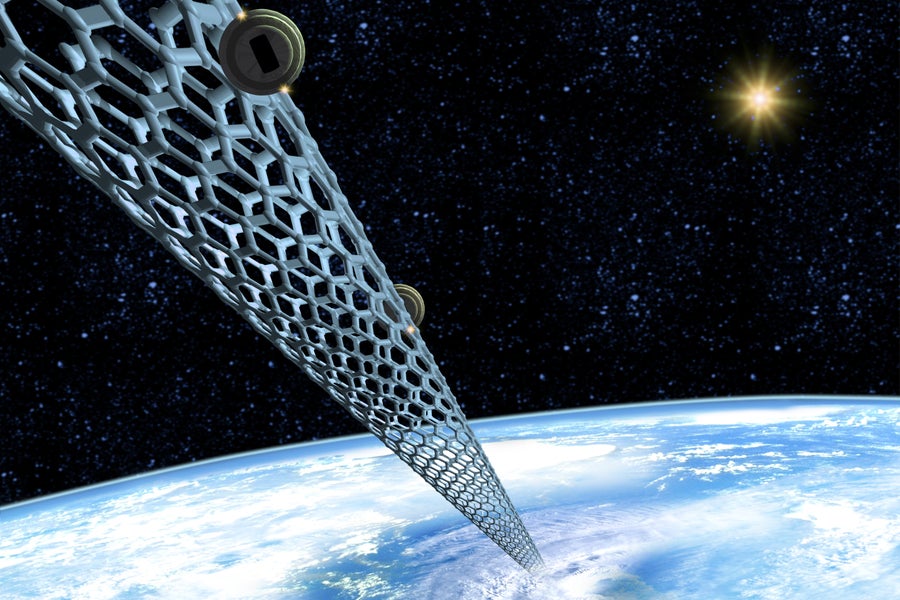For centuries, humanity has looked up at the night sky with wonder, dreaming of touching the heavens. Rockets have carried us into space, satellites orbit our planet, and astronauts have walked on the Moon, yet the cost of space travel remains astronomical—literally. Every kilogram launched into orbit requires immense energy and money. In this context, the concept of a space elevator is as captivating as it is audacious. Imagine a structure so tall it stretches from Earth’s surface to geostationary orbit, allowing cargo and eventually humans to ascend without rockets, smoothly and efficiently. Could this dream become reality in our lifetime? The answer lies at the intersection of physics, engineering, and human ambition.
The Vision of a Space Elevator
The idea of a space elevator may sound like science fiction, but its origins are grounded in scientific reasoning. The first formal concept was proposed by Russian scientist Konstantin Tsiolkovsky in 1895, inspired by the Eiffel Tower. He envisioned a towering structure reaching into space, held upright by the centrifugal force generated by Earth’s rotation. Over a century later, this vision remains tantalizingly possible, though staggering in its technical challenges.
A space elevator would be anchored near the equator, where Earth’s rotational speed is greatest. From there, a cable—or “tether”—would extend upward past geostationary orbit, the altitude at which a satellite orbits in synchrony with Earth’s rotation, approximately 35,786 kilometers above the planet. Beyond this point, the tether would continue to a counterweight, maintaining tension through centrifugal force. Vehicles, called climbers, could ascend the tether using electric motors or other propulsion systems, carrying cargo or passengers into orbit without the explosive combustion of rocket fuel. The concept promises a revolution in space logistics, potentially reducing launch costs from tens of thousands of dollars per kilogram to mere hundreds.
Yet the dream of a space elevator confronts obstacles that test the limits of materials science, engineering, and human ingenuity.
The Tether: The Heart of the Elevator
The most significant challenge in building a space elevator is the tether itself. It must possess extraordinary strength-to-weight ratio, far surpassing any material currently used in conventional engineering. The tether must endure its own weight, the gravitational pull of Earth, the centrifugal force, and environmental hazards such as micrometeoroid impacts, solar radiation, and atmospheric turbulence.
For decades, steel, Kevlar, and even advanced polymers have been considered, but none possess the required combination of tensile strength and low density. Enter carbon nanotubes and graphene—materials whose discovery in the late 20th century sparked hope. Carbon nanotubes are cylindrical molecules composed of carbon atoms arranged in a hexagonal lattice, exhibiting tensile strengths hundreds of times greater than steel while being remarkably light. Graphene, a single layer of carbon atoms in a two-dimensional lattice, shares similar properties.
Despite their promise, producing carbon nanotubes or graphene sheets of sufficient length and flawless consistency is currently beyond industrial capabilities. To build a tether that extends tens of thousands of kilometers into space, scientists must manufacture material that is not only incredibly strong but also defect-free across massive scales. Even minor imperfections could lead to catastrophic failure under stress. Research continues, and incremental progress offers optimism, yet the tether remains the linchpin of feasibility.
Engineering a Climber
Even if a suitable tether were constructed, the challenge of climbing it presents another set of obstacles. Unlike a rocket, a climber would ascend gradually, potentially taking days to reach orbit. It must carry its own power supply, be resistant to space weather, and manage heat generated by friction and electric currents. Engineers have proposed solar panels, wireless energy transmission using lasers, and other innovative solutions to power climbers along the tether.
The climber must also maintain precise navigation. Even a small deviation could cause it to collide with the tether or drift dangerously away from Earth. It must withstand temperature extremes—from blistering sunlight to the chilling vacuum of space—and be resistant to vibrations, wind, and oscillations in the cable. Each ascent would be a delicate ballet of engineering and physics, requiring control systems of unprecedented sophistication.
The Counterweight and Orbital Mechanics
The concept of a space elevator is not simply a tower reaching into space—it is a dynamic structure bound by the laws of physics. The tether must remain taut, balanced by a counterweight beyond geostationary orbit. Some proposals suggest a captured asteroid or purpose-built satellite could serve as the counterweight, providing the outward centrifugal force needed to stabilize the structure.
Orbital mechanics also play a critical role. Earth rotates beneath the tether, and the elevator must remain fixed relative to the planet’s surface. Any wobble or imbalance could produce oscillations that propagate along the cable, threatening the integrity of both tether and climber. Engineers must account for tidal forces, gravitational perturbations from the Moon and Sun, and potential collisions with satellites or space debris.
Environmental and Safety Challenges
The space elevator would be subjected to extreme environmental conditions. High-altitude winds, lightning storms, hurricanes, and even jet streams could buffet the lower sections of the tether. Ascending vehicles could experience turbulence and vibration, and the upper reaches of the cable would face the vacuum of space, radiation from the Sun, and temperature swings of hundreds of degrees.
Micrometeoroids and orbital debris pose additional threats. Even a tiny particle striking the tether at orbital velocities could cause catastrophic damage. Mitigation strategies include shielding, redundancy in tether design, and the use of repair drones capable of performing maintenance thousands of kilometers above Earth. The engineering solution must integrate material science, robotics, and aerospace technology in unprecedented ways.
Safety for humans is another critical consideration. In the event of a tether failure, climbers could fall, generating debris that might damage satellites or even re-enter the atmosphere. Any attempt to transport passengers must therefore adhere to rigorous safety protocols, likely requiring multiple layers of redundancy and emergency systems. The stakes are literally astronomical.
Economic and Political Implications
Constructing a space elevator would not only be a scientific endeavor but also a massive economic and geopolitical undertaking. Funding such a project would require international collaboration on a scale rivaling the Apollo program. The cost of materials, labor, and ongoing maintenance would likely run into hundreds of billions of dollars.
However, the potential rewards are equally staggering. Once operational, a space elevator could enable large-scale construction of space stations, solar power satellites, and interplanetary missions. It could provide affordable access to low Earth orbit, facilitating space tourism, resource mining from asteroids, and even the colonization of the Moon or Mars. The strategic advantages would be enormous, likely sparking both cooperation and competition among nations.
The political landscape would influence feasibility. A tether anchored in one country could raise questions of sovereignty and control. International agreements would be necessary to govern the elevator’s use, ensure safety, and prevent militarization. The project would be as much a diplomatic challenge as an engineering one.
Current Progress and Experiments
Despite daunting challenges, research and experimentation continue. Teams around the world are testing advanced materials, climber prototypes, and energy transmission methods. The Japan Space Elevator Association, for example, has developed small-scale tether prototypes and robotic climbers to study mechanics and control. NASA and other space agencies have sponsored research into carbon nanotube fabrication and tether dynamics.
Some experimental approaches involve building a “tether satellite” system in low Earth orbit as a precursor to a full-scale elevator. These small-scale demonstrations could validate technologies, test materials, and reveal unforeseen complications before committing to a multi-decade construction project.
Private companies are also exploring related technologies. SpaceX and Blue Origin, while primarily focused on rockets, contribute to the broader ecosystem of space infrastructure, potentially paving the way for future tether-based systems. The combination of public and private innovation creates a dynamic environment in which the dream of a space elevator may inch closer to reality.
The Timeline: Could We Achieve It in Our Lifetime?
Estimating when a space elevator could be built involves a mix of optimism and realism. Theoretical models suggest that if we overcome the materials challenge, the engineering and construction phases could take decades. A conservative estimate might place the first operational space elevator in the latter half of the 21st century.
However, breakthroughs in nanotechnology, materials science, and robotics could accelerate this timeline. Imagine a world where defect-free carbon nanotubes can be produced in kilometer-length strands, where autonomous climbers ascend with precision, and where orbital construction is routine. In such a scenario, a space elevator could indeed become feasible within the lifetimes of today’s younger generations.
Yet even with technological readiness, funding, political will, and global collaboration remain unpredictable variables. Unlike rockets, which can be built by a single nation or corporation, a space elevator demands an unprecedented alignment of science, engineering, and international cooperation. Its success will depend not only on our ingenuity but also on our ability to unite behind a vision that reaches beyond Earth.
Philosophical and Cultural Implications
The notion of a space elevator resonates beyond physics and engineering—it touches the human imagination. It represents a bridge between our terrestrial existence and the cosmos, a tangible manifestation of our desire to transcend limitations. For centuries, humans have dreamed of reaching the stars. Rockets took us partway, but a space elevator could make access to orbit as routine as climbing a mountain.
Such a structure challenges our perspective of scale and ambition. Standing at its base, one would look upward at a ribbon disappearing into the sky, a line that threads through clouds, weather, and the edge of space. It would symbolize both human achievement and humility, reminding us that the cosmos is vast, but our curiosity and determination can reach astonishing heights.
Culturally, a space elevator could transform society’s relationship with space. Affordable access to orbit might democratize exploration, fostering new industries, art, and science. It could inspire a generation to dream boldly, to pursue careers in STEM, and to imagine possibilities previously confined to fiction. The elevator would be a monument not just of steel or carbon, but of collective human aspiration.
Conclusion: A Dream Worth Pursuing
Could we build a real space elevator in our lifetime? The answer is uncertain, but the pursuit itself embodies the essence of human curiosity and courage. The challenges—materials, engineering, environmental hazards, economics, and politics—are immense. Yet each obstacle invites innovation, collaboration, and discovery.
The journey toward a space elevator is as significant as the destination. Even if a full-scale structure remains decades away, the research it inspires—advanced materials, autonomous robotics, orbital logistics—propels humanity forward. Every incremental breakthrough brings us closer to a future where space is no longer the exclusive domain of the few but a frontier accessible to all.
A space elevator, if realized, would redefine what is possible. It would transform our relationship with Earth and the cosmos, turning science fiction into tangible reality. And it would serve as a testament to the indomitable human spirit, reminding us that when we look up at the stars, we are not limited by gravity but by the boundaries of our imagination.
To dream of building a bridge to space is to embrace both audacity and responsibility, to recognize that the limits of today may be the stepping stones of tomorrow. Perhaps, in our lifetime, the ribbon to the heavens will rise from Earth, carrying humanity toward new horizons, fulfilling a vision centuries in the making, and reminding us that the sky is no longer the limit—it is only the beginning.






